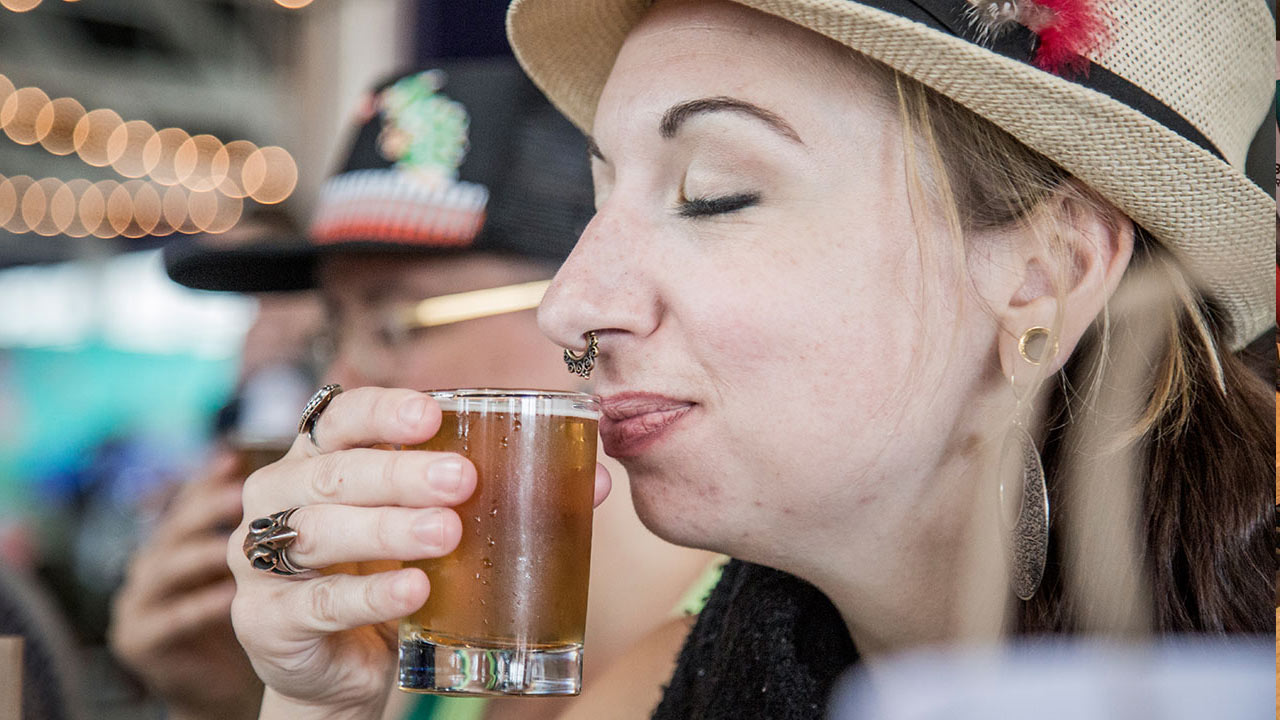Usually when we are tasting beers on our brewery tours the goal is to experience the wonderful beers, learn about new styles and discover which beers we enjoy. This usually involves taking some notes and using some criteria for evaluating the beers. We do not need to be professional judges, but noting what we like about the different beers, and understanding some of the characteristics of the beer enhances our experience and pleasure. It is also fun to compare notes and even pick out a favorite beer. The Virtual Lockdown Beer Tasting Kit provides some materials for taking notes, organizing our thoughts and finding the right words for what we are tasting.
Included in the kit:
- Beer tasting score sheet. This sheet has space to grade and take notes for four beers. There is an area to record the name, IBU, ABV, and appearance of each beer. You can rate each beer on aroma, flavor, mouthfeel and your overall impressions, as well as an area to take notes. Print out as many as you need.
- Beer Mat. We can’t send fancy flight boards like the ones you see in most breweries through the internet, but you still need to line up the beers for comparison. Each beer mat has a spot for four beer glasses with a place to list its name.
There are also reference guides included with information about common beer flavor components.
Evaluating or Judging your Beer
When we are experiencing beer, we use most of our senses. How the beer looks, how it smells, how it tastes and how it feels in our mouth are all part of the experience. So, give yourself time to enjoy and evaluate each sensation. Keep in mind, these are your tastes and experiences so don’t worry too much about this. You are not judging the finalists at the Great American Beer Festival. You are experiencing beers to learn more about different styles and finding beers that you like. So, if you don’t like a beer, that is ok. This is one of the reasons there are so many different types of beers. There are plenty of beers just for you.
Appearance
What does the beer look like? First and foremost, the beer should be visually appealing. Right off you will notice the color. This can range from a clear, pale yellow or golden color, to a deep, opaque black. Next is the clarity or the haziness of the beer. Each style has its own appearance. Pilsners are clear and pale, NEIPAs are golden and hazy, and stouts are dark as night. Is there a lot of carbonation? How is the head? Does the beer look appealing? Write down your impressions.
Aroma
Next hold the glass under your nose, no need to stick your nose into the glass, just hold it six to ten inches under your nose and take a whiff. What do you smell? Pine needles? Citrus? Fresh cut hay? Coffee or Chocolate? Does it smell like something is off, like wet newspapers or an old horse saddle? Or is there odor you just can’t name?
One of the problems with odors is that smells are processed in the amygdala, deep inside the brain. The amygdala processes memories and emotions, one of the reasons that smells often trigger long forgotten memories and deep emotions, but the amygdala does not process speech and language. This may be why most people have a hard time articulating or finding words to describe smells. For whatever reason, even experienced beer judges have a hard time agreeing on the exact description of aromas found in beer. So do not feel bad if you cannot identify or describe that smell that you just know you know. After a while you will start to recognize different beers by their aroma.
Beer aromas generally are produced by three sources.
- Hops, often referred to as barnyard smells such as hay, grass, pine, fruit or flowers.
- Malt, often referred to as kitchen smells such as grain, toast, chocolate or caramel.
- Yeast, often referred to as yeast smells like banana, clove, spice, apple or bubble gum.
Taste
Next take a sip of beer. Take enough to cover your tongue. You have a lot of taste buds and we want to give them all a chance to taste the beer. The descriptions of the flavors of beers are wide ranging and can seem a little odd for the beginning beer drinker. Did someone really describe that beer as tasting like “wet potter’s clay, waxy flax and sesame chocolate candy”? There are a lot of ways to describe the taste of a beer and the best words to use are the ones that make sense to you. Included in your tasting packet is CraftBeer’s Beer Flavor Six Pack that breaks down most beer flavors into six categories.
- Crisp & Clean
These beers are clean and refreshing on the palate. Usually with a nice balance of hops and malts. Think of a Pilsner or Blonde Ale. - Malty & Sweet
These beers get their flavors from the malt and can be toasty like a Brown Ale or Schwarzbier or have a dried fruit or caramel character like an English Bitter or a Scotch Ale. - Dark & Roasty
Dark roasted malts bring out coffee or cocoa notes. These beers can be dark and malty like a Robust Porter or Brown Ale, or dark and dry like an Irish Dry Stout or a Black Ale. - Hoppy & Bitter
The bitterness comes primarily from the hops. Depending upon the hop and the malt bill the beer can be extremely bitter or bitter but balanced with the malt. IPAs and Pale Ales fall into this flavor profile as well as Steam Beer and some Amber Ales. - Fruity & Spicy
Beers can have both malt and hoppy flavors while featuring bright yeasty flavors like fruit, spices and bubble gum. Belgian Ales move to the front with these flavors. Think of a Saison or a Belgian Golden Strong Ale. Dark fruit flavors can be found in a Belgian Dark Strong Ale or a Quadrupel. Fruits and spices are often added to these beers. - Sour, Tart & Funky
When a bacterium such as Lactobacillus or a special yeast like Brettanomyces gets involved the results can be especially interesting. A tart, lightly acidic Berliner Weiss or a Göse can be refreshing. Sour beers such as Belgian Flanders, Fruit Lambic or a Sour Kettle beer can be mouth puckering. Funky, farmhouse beers like a Saison or Gueuze are spicy with a distinct flavor.
Mouthfeel
While the beer is in your mouth, pay attention to how it feels, what kind of sensations do you notice. Is the body of the beer light or thick and creamy? What about the carbonation? Do you feel the warmth of the alcohol? Do you notice astringency? Does the beer make you pucker or make your mouth feel dry? Do you feel the spices? How does the temperature of the beer feel?
All these factors affect how we react to a beer and can contribute to or lessen our enjoyment. This is a very subjective evaluation and if you like the mouthfeel then give it a higher rating.
Overall Impression
The appearance, aroma, flavors and mouthfeel all contribute to the entire experience of tasting a beer. As we drink the beer our brains are evaluating all the sensations and contributing to our overall impression of the beer. This is why the second sip of a beer often tastes different then the first sip. Especially when there was another flavor in our mouth. For example, a hoppy IPA may be overwhelming on the first taste but becomes more palatable after a couple of sips. If you are drinking a nice, clean Pilsner, then take a sip of a sour Lambic, the Lambic will taste very, very sour. But give your palate a rest, wait a beat, then try a couple of more sips and you will adjust to the new flavors.
After you have had a few tastes of the beer, and you have given all your senses a chance to evaluate the beer, how does it make you feel? Is it a beer you would like to try again? Or is it a beer you’ll drink if it is around, but you are not going to hunt it down? Perhaps this will become your new “go to” beer. Grade the beer and give it your overall impression.
Compare Notes
Compare your tasting notes with your friends. It would be best to hold your comments until everyone has had a chance to taste the beer and evaluate it for themselves. Everyone will react to the beer differently and it can be a very personal and subjective experience. What you may like, your friend will hate and what you hate your friend may like. That is fine, the purpose of tasting a variety of beers is to find out what we like and compare our tastes with others. I have been on tastings where someone will take a sip of the beer and loudly exclaim, “Gad, that is a funky beer! It’s disgusting! Wow!” After that everyone said pretty much the same thing. I have no doubt that this person didn’t like the beer, but his outburst prejudiced everyone else on the tasting and that beer got the lowest rating of the day. The worst part was the person didn’t understand the flavor vocabulary. That beer was a lot of things, but it most definitely was not funky. The point is, keep your comments to yourself until everyone has had a chance to taste the beer and record their impressions.
You don’t have to declare a winner, but it would be fun to see if there was one beer that rated higher than the others. If you feel like giving accolades perhaps you can give some that are unique to your group or the beers tasted. How about unique classifications such as:
- The best beer to drink while socially isolated
- The first beer I want to drink after the coronavirus lockdown is over
- Best beer to drink while watching old basketball games
- Best beer to drink while binge watching Netflix
- The worst beer to drink alone
- Most unusual flavor description
- The beer I least expected to like
- Our new most favorite beer of all time, or at least for this week
Share Your Tastings and Beer Lists
Let others know about your beer tasting and what you think of the beers. Post your tasting list, beer photos, the winners and other descriptive accounts to social media such as Facebook, Instagram or Twitter. Be sure to tag the breweries and use #lockdownbeertasting and #virtualbeertasting. If you want to tag @seattlebrewerywalkingtours that would be groovy too.
Let me know how it went. I’m looking forward to hearing about your experience.
More Resources for your Virtual Beer Tasting
For more information about organizing your own virtual beer tasting, take a look at our blog on Conducting a Beer Tasting During the Coronavirus Lockdown and our tips on serving your beers and organizing you beer flights for your tasting. You can get all this information by downloading our Virtual Lockdown Beer Tasting Guide.
Feature photograph by David Horvitz




